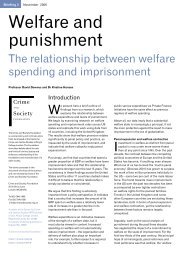PRISON SERVICE
PRISON SERVICE
PRISON SERVICE
- No tags were found...
You also want an ePaper? Increase the reach of your titles
YUMPU automatically turns print PDFs into web optimized ePapers that Google loves.
and Nigeria. 8 This varies according to national context:for example a large portion of drug mules in Australiaare from Thailand and Vietnam. 9 Research in the USAfinds a high portion of women mules are from Jamaicaand South America. 10 A significant portion of womenmules are single parents. Research on Colombianwomen mules in prison in Europe found that 85 per centwere single parents. 11 This is also true of women mulesfrom Jamaica imprisoned in the UK and the USA. 12To an extent, these demographics can be interpretedto explain the phenomenon of drug mules. The firstresearch on the subject, conducted by Rosa del Olmo inVenezuela, concluded that economic crisisdisproportionately affected women and contributed totheir entry into the international cocaine trade as mules. 13This hypothesis has been largely borne out in researchwhich asks mules about their motivations. Research withfemale Colombian mules found that many weremotivated by financial concerns connected to women’srole as the head of the household. 14 Likewise, researchwith Jamaican mules found that most women weremotivated by economic need. 15 Writing twenty years afterRosa del Olmo, Julia Sudbury similarly concludes that neoliberaleconomic globalisation has exacerbated developingworld poverty and women continue to bedisproportionately affected as the financial heads of thehouseholds. 16Penny Green conducted research with Nigerian menand women imprisoned in the UK. She concludes that forboth: ‘relative poverty, a sense of desperation andopportunity to rise above the grinding misery of economichardship in the developing world all contribute to arational explanation of the phenomenon’. 17 Her researchwith British mules found that they were motivated bysimilar concerns as those mules from the developingworld: debt, economic distress and (in the 6 cases of 130female couriers which she presents) ‘external pressure’from older, more powerful men. 18 In addition she foundthat six (of the 18 couriers she interviewed) were ‘the veryyoung who see it as part of an exciting lifestyle and/or ameans to another better way of life’. 19Lastly, some research has highlighted the role ofcoercion and threat in motivating drug mules. 20 This claimremains contentious as it is extremely difficult for mules toprove that they were coerced. On the other hand, there isa widespread belief that mules may ‘cry wolf’ in the hopeof a more lenient sentence but on the other hand mulesmay not speak to the authorities for fear of retribution.In sum, existing research shows that deprivation isundoubtedly an important context in mules’ motivations.However, since research has tended to focus only mulesfrom the developing world, it is hardly surprising that theyshould cite poverty as a motive when they find themselvesimprisoned in the developed world. Furthermore, to saythat people commit crime because of poverty issomewhat simplistic: it does not explain why peopleoffend at a particular time, why one type of crime iscommitted over another, or why more men than womenare mules, if women are disproportionately affected byeconomic crisis. Lastly, existing research has mostlysidelined the possibility alternative or simultaneousmotives for offending. Research on women drug dealersuncovered a much wider variety of motivations thanresisting poverty such as autonomy, respect, gaining asense of control over their lives, achieving respectability aswell as enjoyment. 21 Thus the purpose of this research wasto re-examine the motives of a diverse group of mulesand in particular to consider what the role of povertymight be.Methodology and participantsData for this research was collected through 15months of ethnographic research in women’s and men’sprisons in Quito, Ecuador. The researcher spent 4-5 days aweek in prison with convicted drug traffickers in order to8. Sudbury, J. (2005). ‘Mules,’ ‘Yardies’ and other folk devils: Mapping cross border imprisonment in Britain. Global lockdown: race,gender, and the prison-industrial complex. J. Sudbury. New York, N.Y. ; London, Routledge: xxviii, 323 p.Green (1994).9. Australian Bureau of Statistics (2010), Prisoner Characteristics: Australia, available online:http://www.abs.gov.au/ausstats/abs@.nsf/Products/4517.0~2009~Chapter~Prisoner+characteristics,+Australia?OpenDocument#21302313271899535399213023132718995010. Huling, T. (1995). “Women drug couriers: Sentencing reform needed for prisoners of war.” Criminal Justice 9(15).11. Dorado, M.-C. (2005). Desventajas del castigo penal ‘exclusivo’ a las colombianas, mensajeras de drogas en Europa [Disadvantages ofthe ‘exclusive’ penal punishment of columbian drug messengers in Europe]. Delitos y Fronteras:Mujeres extranjeras en prisión [Crimesand Borders: Foreign women in prison]. M. T. Martín Palomo, M. J. Miranda López and C. Vega Solís. Madrid, Editorial Complutense.12. Sudbury (2005, see also Huling, T. (1995). “Women drug couriers: Sentencing reform needed for prisoners of war.” Criminal Justice9(15).13. Olmo, R. D. (1990). “The Economic-Crisis and the Criminalization of Latin-American Women.” Social Justice-a Journal of CrimeConflict and World Order 17(2): 40-53.14. Dorado, ibid.15. Sudbury (2005).16. Ibid.17. Green, P. (1998). Drugs, trafficking and criminal policy: the scapegoat strategy. Winchester, Waterside Press.. p. 18.18. Ibid.19. Ibid, p.93.20. Sudbury (2005).21. Denton, B. (2001). Dealing: Women in the Drug Economy. Sydney, Australia, University of New South Wales Press.4 Prison Service JournalIssue 192











